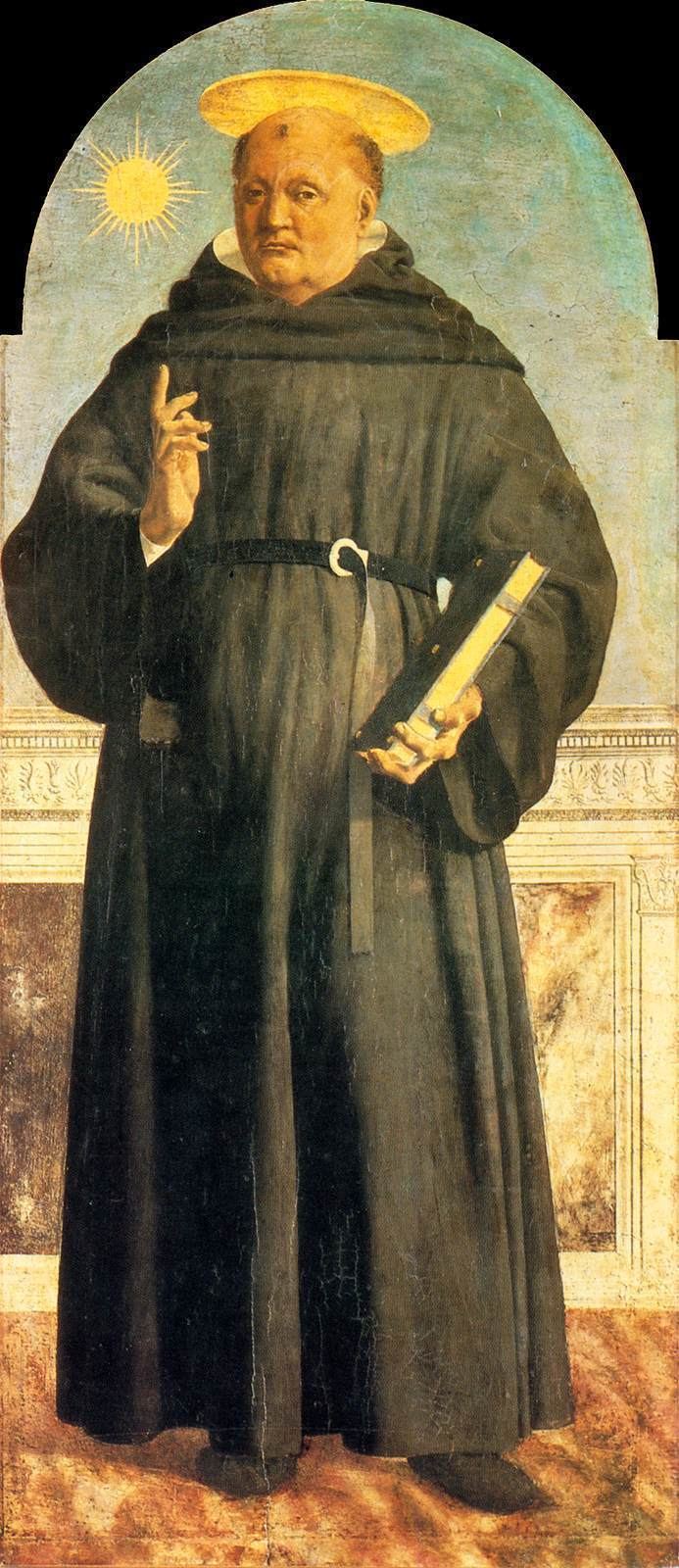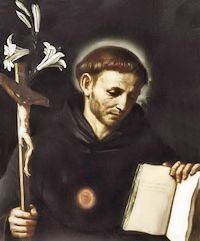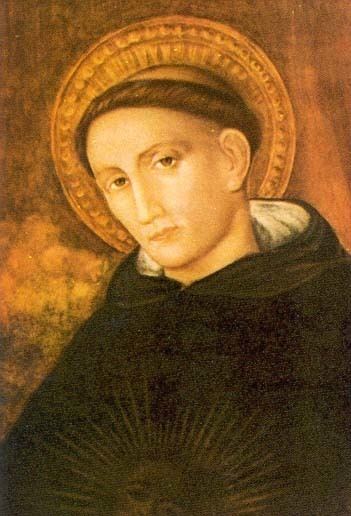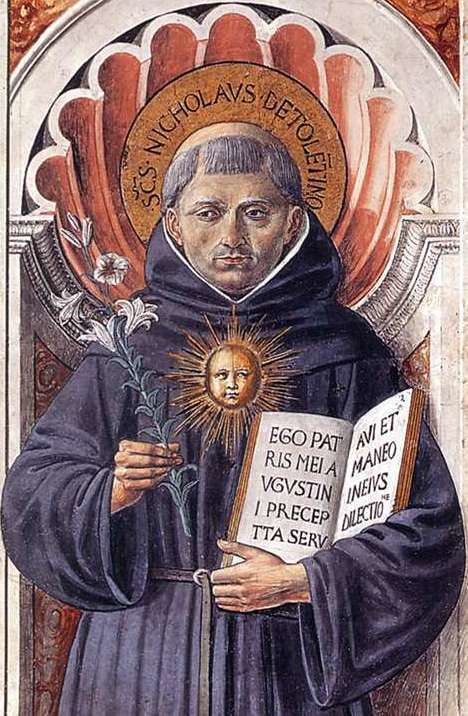Venerated in Roman Catholic Church | Feast September 10 | |
 | ||
Attributes Augustinian holding a bird on a plate in the right hand and a crucifix on the other hand; holding a basket of bread, giving bread to a sick person; holding a lily or a crucifix garlanded with lilies; with a star above him or on his breast; Patronage animals; babies; boatmen; diocese of Cabanatuan, Philippines; dying people; Lambunao, Philippines; Guimbal, Iloilo, mariners; diocese of Mati; holy souls; Philippines; sailors; sick animals; souls in Purgatory; diocese of Tandag, Philippines; watermen; patron saint of Surigao City, La Huerta, Paranaque City and Buli and Cupang in Muntinlupa City, San Nicolas, Ilocos Norte a town named after St. Nicholas De Tolentino, Banton, Romblon in the Philippines Died September 10, 1305, Tolentino, Italy People also search for Saint Nicholas, Pope Mark, Catervus | ||
Saint nicholas of tolentino september 10
Nicholas of Tolentino (Italian: San Nicola da Tolentino, Spanish: San Nicolas de Tolentino) (c. 1246 – September 10, 1305), known as the Patron of Holy Souls, was an Italian saint and mystic.
Contents
- Saint nicholas of tolentino september 10
- Saint Nicholas of Tolentino Preview
- Biography
- Legends
- Veneration
- Iconography
- References

Saint Nicholas of Tolentino Preview
Biography

Nicholas Gurrutti was born at Sant'Angelo in Pontano in Italy, in what was then the March of Ancona. He was the son of parents who had been childless into middle age. Compagnonus de Guarutti and Amata de Guidiani prayed at the shrine of Saint Nicholas of Myra for his intercession, and when Amata became pregnant they named their son after the saint.

A studious, kind and gentle youth, at the age of 16 Nicholas became an Augustinian Friar and was a student of the Blessed Angelus de Scarpetti. A monk at the monasteries at Recanati and Macerata as well as others, he was ordained in 1270 at the age of 25, and soon became known for his preaching and teachings. Nicholas, who had had visions of angels reciting "to Tolentino", in 1274 took this as a sign to move to that city, where he lived the rest of his life. Nicholas worked to counteract the decline of morality and religion which came with the development of city life in the late thirteenth century.

On account of his kind and gentle manner his superiors entrusted him with the daily feeding of the poor at the monastery gates, but at times he was so free with the friary's provisions that the procurator begged the superior to check his generosity. Once, when weak after a long fast, he received a vision of the Blessed Virgin Mary and Saint Augustine who told him to eat some bread marked with cross and dipped in water. Upon doing so he was immediately stronger. He started distributing these rolls to the ailing, while praying to Mary, often curing the sufferers; this is the origin of the Augustinian custom of blessing and distributing Saint Nicholas Bread.

In Tolentino, Nicholas worked as a peacemaker in a city torn by strife between the Guelphs and Ghibellines who, in the conflict for control of Italy, supported the Pope and the Holy Roman Emperor respectively. He ministered to his flock, helped the poor and visited prisoners. When working wonders or healing people, he always asked those he helped to "Say nothing of this", explaining that he was just God's instrument.
During his life, Nicholas is said to have received visions, including images of purgatory, which friends ascribed to his lengthy fasts. Prayer for the souls in purgatory was the outstanding characteristic of his spirituality. Because of this Nicholas was proclaimed patron of the souls in Purgatory, in 1884 by Leo XIII.
Towards the end of his life he became ill, suffering greatly, but still continued the mortifications that had been part of his holy life. Nicholas died on September 10, 1305.
Legends
There are many tales and legends which relate to Nicholas. One says the devil once beat him with a stick, which was then displayed for years in his church. In another, Nicholas, a vegetarian, was served a roasted fowl,for which he made the sign of the cross, and it flew out a window. Nine passengers on a ship going down at sea once asked Nicholas' aid, and he appeared in the sky, wearing the black Augustinian habit, radiating golden light, holding a lily in his left hand, and with his right hand, he quelled the storm. An apparition of the saint, it is said, once saved the burning palace of the Doge of Venice by throwing a piece of blessed bread on the flames. He was also reported to have resurrected over one hundred dead children, including several who had drowned together.
According to the Peruvian chronicler Antonio de la Calancha, it was St. Nicholas of Tolentino who made possible a permanent Spanish settlement in the rigorous, high-altitude climate of Potosi, Bolivia. He reported that all children born to Spanish colonists there died in childbirth or soon thereafter, until a father dedicated his unborn child to St. Nicholas of Tolentino (whose own parents, after all, had required saintly intervention to have a child). The colonist's son, born on Christmas Eve, 1598, survived to healthy adulthood, and many later parents followed the example of naming their sons Nicolas.
Veneration
Nicholas was Canonized by Pope Eugene IV (also an Augustinian) in 1446. He was the first Augustinian to be canonized. At his canonization, Nicholas was credited with three hundred miracles, including three resurrections.
The remains of St. Nicholas are preserved at the Shrine of Saint Nicholas in the Basilica di San Nicola da Tolentino in the city of Tolentino, province of Macerata in Marche, Italy.
He is particularly invoked as an advocate for the souls in Purgatory, especially during Lent and the month of November. In many Augustinian churches, there are weekly devotions to St Nicholas on behalf of the suffering souls. November 2, All Souls' Day, holds special significance for the devotees of St. Nicholas of Tolentino.
St Pius V did not include him in the Tridentine Calendar, but he was later inserted and given September 10 as his Feast day. Judged to be of limited importance worldwide, his liturgical celebration was not kept in the 1969 revision of the General Roman Calendar, but he is still recognized as one of the saints of the Roman Catholic Church.
A number of churches and oratories are dedicated to him, including San Nicolo da Tolentino in Venice, San Nicola da Tolentino agli Orti Sallustiani in Rome, Saint Nicholas of Tolentino in The Bronx, New York, and Saint Nicholas of Tolentino in Bristol, UK. In the Philippines, the 16th century Church of San Nicolas de Tolentino in Banton, Romblon, was built in honor of him and his feast day is celebrated as the annual Biniray festival, commemorating the devotion of the island's Catholic inhabitants to St. Nicholas during the Muslim raids in the 16th century.
In the province of Pampanga, A 440-year-old Augustinian church, which was founded in 1575, built in his honor is located in the heart of Macabebe, Pampanga. The heritage church measures 70 meters (230 ft) long, 17 meters (56 ft) wide and 11 meters (36 ft) high. The facade of the church has scantly ornamentation and its architectural symmetry is lost amid and the various forms assumed the windows and the main entrance. Simple neo-classic lines of the facade. Presently, a second class relic of the saint is venerated every Tuesdays after the mass.
Iconography
He is depicted in the black habit of the Hermits of St. Augustine — a star above him or on his breast, a lily, or a crucifix garlanded with lilies, in his hand. Sometimes, instead of the lily, he holds a vial filled with money or bread.
